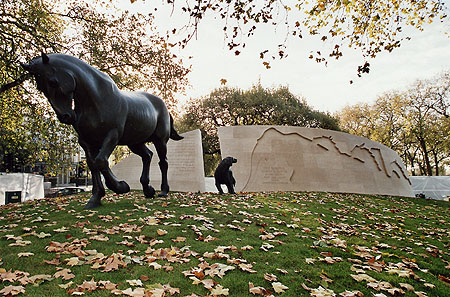Animals
Prior to the outbreak of WW1 in 1914 the use of animals for combat (ie. the cavalry horse) upon which the fighting soldier rode into battle, was as important as the use of horses for transportation. With the advancement of warfare technology and the mechanization of armies worldwide the use of animals in combat situations became less appropriate. By the end of the First Word War in 1918 the primary employment of animals, by all the armies, was for transportation, communication and a variety of other support needs.
Animal Logistics in World War 1
WW1 took place on two major fronts in the East and West of Europe and in the Middle East, North Africa and many colonies Worldwide. This meant that it was necessary to transport the animals to where they were required to be, along with their handlers and the fighting men. In 1914 the Russians had thirty six cavalry divisions which they transported by train into positions along the 1,000 miles of the Eastern front. Thus the animals themselves required transport.
In 1917, the Australian Cavalry were shipped halfway around the World!
The logistics of the supply needs (for the animals had to be fed and watered) brought into play their own problems which the armies dealt with as the war progressed. The Germans bred and acquired animals prior to the start of the war and then also took animal ‘prisoners’ after gaining territory. The British and Americans bought horse and livestock form their own peoples and press-ganged draught animals into service. They were then trained and shipped to the fronts or where ever it was that they were needed.
The numbers of animals used by all the fighting forces during the Great War was phenomenal – in the millions! There were pigeons used to carry messages in Europe and camel cavalry [on both sides] carried men and supplies in the desert regions. Mules, oxen, reindeer and dogs pulled wagons and sleighs where the terrain permitted. The care and maintenance of all these animals was essential. As the war progressed farms were maintained by the armies. These farms housed livestock, grew and harvested food. Also it was necessary to feed the armies.Thus flocks of sheep were kept as “camp followers” that moved behind the fronts and provided mutton for the men. Bully Beef, cattle raised in the USA and Canada, was shipped in cans to the troops in Europe.
WWI Injured Animals
Huge numbers of animals were being killed and injured. After all animals were just as susceptible to the effects of mustard gas and shells as were men, animals also have illnesses and suffered from shell shock. It was in order to deal with some of these horrors of warfare that the British Blue Cross volunteer society performed the same services for the animals of war that the Red Cross did for the human casualties. Veterinarians were an integral part of the Allies and the Central Forces. The British army had the Royal Veterinary Corps serving throughout the war zones.
And The Ending

The Animals In War Memorial - Brook Gate, Park Lane, London, England
Animal hospitals were set up where they were needed and by the end of the war there were six in the west of France alone.
After the war the Australians sold most of their surviving horses to the British who moved them to their cavalry units in India. The Americans were able to sell some of the surviving horses back to their original owners.
The Animals in War memorial in London is a powerful tribute to all the animals that served, suffered and died alongside the British, Commonwealth and Allied forces in the wars and conflicts of the 20th century.
Spanning nearly 60 feet wide and deep on two levels, it’s a a stunning visual monument sculpted by artist David Backhouse. It was presented to the world on the 90th anniversary of the Great War in 2004.
… A fitting tribute to the horses, camels, dogs, oxen, birds, and even worms and more who helped and sacrificed in the war effort.